Sichuan, China – Thursday, March 31st to Monday, April 4th, 2011
I was very close to not going to Chengdu. It was somewhere on my list of places I wanted to visit in China, but wasn’t especially high on the “must visit” ranking. I found the semester flying by faster than anticipated, exams and finances both proved more challenging than I originally expected, and it was feeling overwhelming to try to plan a weekend trip deep into the mainland, especially when it became evident that I would be going by myself. I was actually leaning towards not going and saving the money for my higher-priority trips later in the spring. I decided to confirm with a friend that staying put would be the wisest decision, but was surprised by their blunt answer: “Just go. Don’t regret it.”
to try to plan a weekend trip deep into the mainland, especially when it became evident that I would be going by myself. I was actually leaning towards not going and saving the money for my higher-priority trips later in the spring. I decided to confirm with a friend that staying put would be the wisest decision, but was surprised by their blunt answer: “Just go. Don’t regret it.”
This proved to be very good advice. Not only was my weekend trip to China’s southwestern Sichuan province one of the best parts of my entire spring in Asia, it was also easily the greatest value. Taking a flight out of Shenzhen instead of Hong Kong made the flight very economical. I hailed a motorized scooter driver upon my late arrival, and despite the driver getting lost (and refusing to admit that he was lost, probably due to the language barrier) got me from the airport to my hostel for just a couple of bucks. And the hostel itself (Lazy Bones) was without a doubt the best I stayed at in all my time as a student traveler; friendly, accommodating, cheap food and activities, and averaged less than $8.00 per night, all fees included.
The next night they offered a free dumpling making class. This was a very delicious and cost-effective way to enjoy dinner in Chengdu, as well as get to socialize with travelers from all over the world. While we made plenty of traditional dumplings, the last plate we were encouraged to create “artistic” dumplings, pictured (pre-cooked) below. I made the long snake. It didn’t hold together very well.
I checked online and, nine years later Lazybones is still in business offering the same experience for an ultra-cheap price.
The hostel also organized an early morning group tour to the Chengdu Research Base of Giant Panda Breeding (or the “Panda Base” as it’s more simply called). The base is home to the world’s largest collection of Giant and Red Pandas on public display, and has been responsible for well over 100 Giant Panda births.
We arrived at 8:30 in the morning as soon as the Base opened to visitors. This was both to beat the crowds and to see the pandas at their most active, which tends to be early mornings. Plus the morning mist provided a tranquil atmosphere.
And behold… pandas!
More pandas!
Pandas napping!
Pandas eating!
Pandas eating in a silly way!
Really, the Panda Base is home to a ridiculous amount of Giant Pandas.
It’s quite easy to get jaded to pandas after a while. In the US, just getting to see two Giant Pandas in an exhibit is an experience people will gladly queue hours for. Here, I quickly began to hope the next exhibit would contain something other than yet another Giant Freakin’ Panda.
Fortunately, they do have a collection of adorable Red Pandas (which actually aren’t closely related to the Giant Panda) to spice things up.
In here you could pay 1000 yuan to hold a panda and get your picture taken with it. I declined the offer but three of our group decided to do it.
I believe they may have been trying to collect a panda for the next of these photo shoots.
They also had a nursery where we could view the baby pandas. Adorable.
So much for my hope of ordering a panda stew.
 I was amused by this information panel which has completely made-up numbers exaggerating the length of time various species have been on the planet. I don’t think monkeys have been around for 300 million years old considering the Cretaceous period ended only 65 million years ago, nor have crocodiles been around for “more than 2 billion years” considering the geological earth is only about 4.5 billions year old.
I was amused by this information panel which has completely made-up numbers exaggerating the length of time various species have been on the planet. I don’t think monkeys have been around for 300 million years old considering the Cretaceous period ended only 65 million years ago, nor have crocodiles been around for “more than 2 billion years” considering the geological earth is only about 4.5 billions year old.
Before exit we saw this group of Chinese school children. Whenever they see a westerner they excitedly wave their hands and shout “Hello!” so we got a lot of attention.
But there’s just one last thing: CRAZY CRACK PANDA!!!
 Back in Chengdu, I had time to wander around the city after buying my bus tickets to Jiuzhaigou for the next day.
Back in Chengdu, I had time to wander around the city after buying my bus tickets to Jiuzhaigou for the next day.
Being early April near the mountains of western China, there was a lot of mist in the air.
Chengdu has a reputation as one of China’s most livable cities. Just walking around the urban core on an extremely cloudy day, I didn’t get quite the same sense of culture or history as I do with other more tourist-heavy cities around Asia, but that’s clearly not the best metric to judge overall quality-of-life metrics. As per most Chinese cities, traffic isn’t great to deal with especially as a pedestrian.
 Tianfu Square is the city’s largest public square at the center of Chengdu, featuring a nearly 100-foot tall statue of Mao Zedong. I’ll return again later when visibility was better.
Tianfu Square is the city’s largest public square at the center of Chengdu, featuring a nearly 100-foot tall statue of Mao Zedong. I’ll return again later when visibility was better.



 A short walk away is the entrance to the People’s Park, one of many such named public parks found in China.
A short walk away is the entrance to the People’s Park, one of many such named public parks found in China.
Peculiar phrasing, but the sentiment seems nice.
With spring the cherry blossoms had arrived; one of the brightest spots on an otherwise gloomy day.
Despite the cool, damp weather, the People’s Park was quite popular with locals.
They even had live cultural performances. Chengdu is located close to the Tibetan plateau, and while the city is predominantly the majority Han ethnicity, there are stronger influences of China’s minority cultures than you’d find in most coastal or central Chinese cities.
Apparently one thing People’s Park in Chengdu is famous for is ear cleaning service. They stick a little metal rod in your ear and use high-frequency vibrations (by tapping on it) to clear out the ear wax. For obvious reasons I didn’t seek it out, even if my ears could have used a good cleaning. (The poor air quality in China does have a few side-effects after a prolonged exposure.) So here’s some other photos from People’s Park instead.
Less popular on a day like today was the amusement center located in People’s Park, which was completely shuttered due to rain.
Obligatory copyright infringement.
Unfortunately this meant I would miss the park’s children coaster called Space Car to add to my count today.
Fortunately I still had another drier day on which I could return and quickly nab the credit!
Back to the first day, while Chengdu doesn’t have a huge cultural or historical district, there are a few smaller sites to check out, like the Wen Shu Temple.

 The rain kept the Wenshu Fang Old Quarter rather quiet this day.
The rain kept the Wenshu Fang Old Quarter rather quiet this day.




 Crossing back over the North river. My map indicated there was something called the “Rainbow Bridge” here, although it was much less colorful than expected.
Crossing back over the North river. My map indicated there was something called the “Rainbow Bridge” here, although it was much less colorful than expected.
While today Chengdu has a comprehensive metro system running throughout the city, in 2011 all that existed was the recently opened Line 1, a straight north-south line directly under the city’s main Renmin Road. While very modern, with no connections it had yet to find a user base amongst the locals.
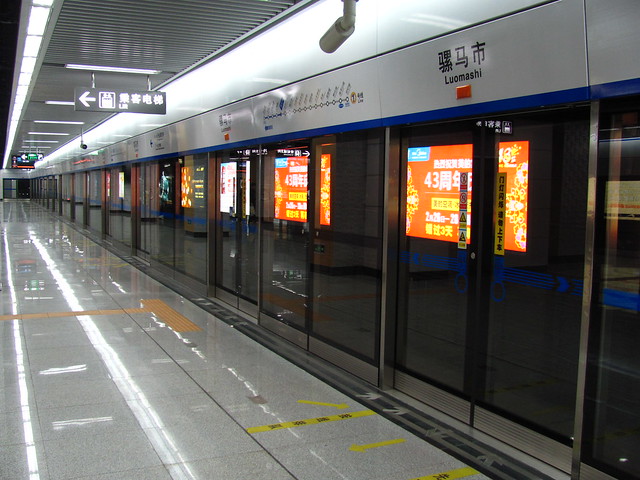 I used the Metro to return to Tianfu Square on my last night in Chengdu. I had met some other students on my trip to Jiuzhaigou and upon our return to Chengdu agreed to meet up for a meal near Tianfu. I got there a bit early and took some better photos of the Mao statue standing before the Sichuan Science & Technology Museum.
I used the Metro to return to Tianfu Square on my last night in Chengdu. I had met some other students on my trip to Jiuzhaigou and upon our return to Chengdu agreed to meet up for a meal near Tianfu. I got there a bit early and took some better photos of the Mao statue standing before the Sichuan Science & Technology Museum.
Most contemporary Chinese people’s relationship to Mao Zedong is rather strange. He’s everywhere in China, including currency, street names, and monuments such as this one (which is somewhat atypical in its scale and prominence within the city). Yet there’s also a curious silence around him; whatever their feelings for him, it seems that most Chinese are aware that Mao isn’t without controversy even in his home country and for the modern direction of the Communist Party, and generally decide to keep their opinions private. In most people’s view, discussing politics can only lead to trouble, so don’t do it. That seems doubly true when it comes to the issue of Mao’s legacy.
The haze hanging in the air, the rest of Tianfu Square has an eerily empty modernity to it. Like the statue of Mao, it’s as if the city center was designed for much grander beings than mere humans.
Bye, bitch.
 Along with the pandas, the best part of Chengdu was undoubtedly the food. Chengdu is the epicenter for Sichuan (or “Szechuan”) cuisine, which is what most Americans think of when they think of “spicy Chinese food”. Of course, most actual Chinese food isn’t anything like the American counterparts, which meant I had never tried Chengdu’s most famous dish before, hot pot.
Along with the pandas, the best part of Chengdu was undoubtedly the food. Chengdu is the epicenter for Sichuan (or “Szechuan”) cuisine, which is what most Americans think of when they think of “spicy Chinese food”. Of course, most actual Chinese food isn’t anything like the American counterparts, which meant I had never tried Chengdu’s most famous dish before, hot pot.
Hot pot features a boiling vat of spicy, oily soup at the center of the table in which to dip various meats and veggies. While popular throughout China, Chengdu is known for an extremely spicy version of hot pot, often regarded as the definitive version.
Trying one’s first hot pot in Chengdu is very much like learning to swim in the deep end of the pool, if that pool was filled with mouth-numbing peppercorns and enough chili flakes to float atop of.
While I’d have a tough time saying I “enjoyed” this meal, nearly nine years later I still rank it as one of the most memorable dining experiences I’ve ever had in my life, and near or at the top of the list of gastronomical experiences I’d have on this Asia trip.





















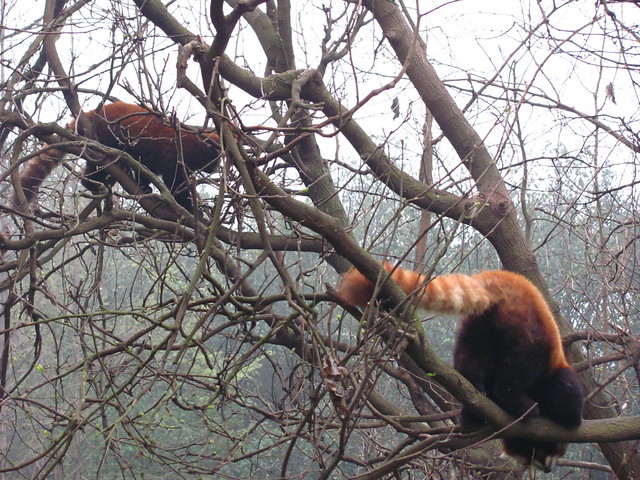














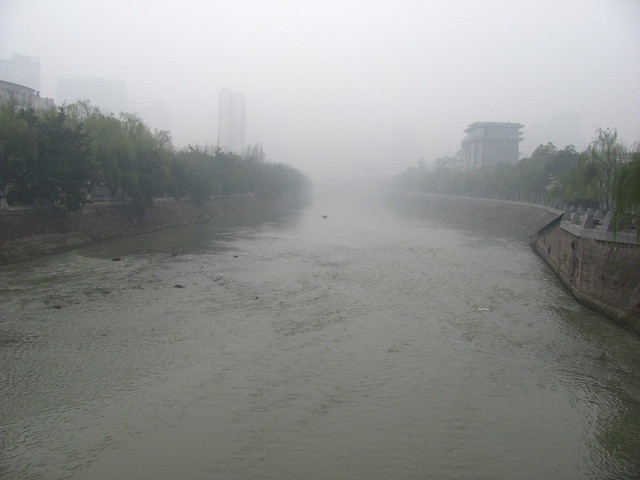

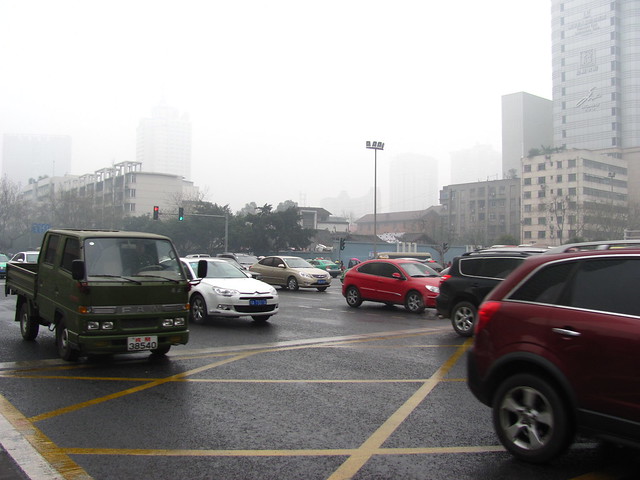
























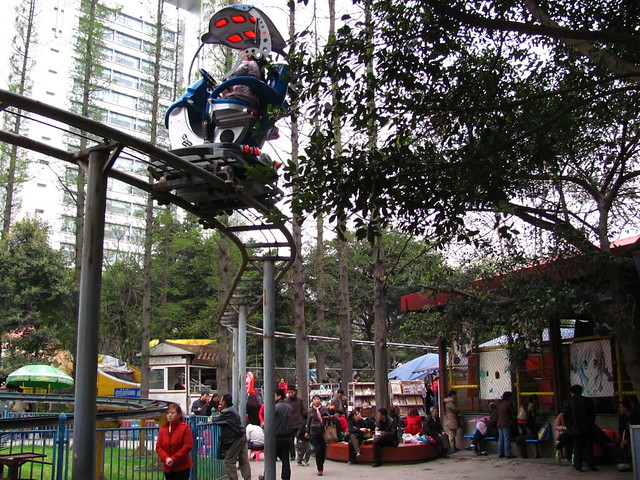















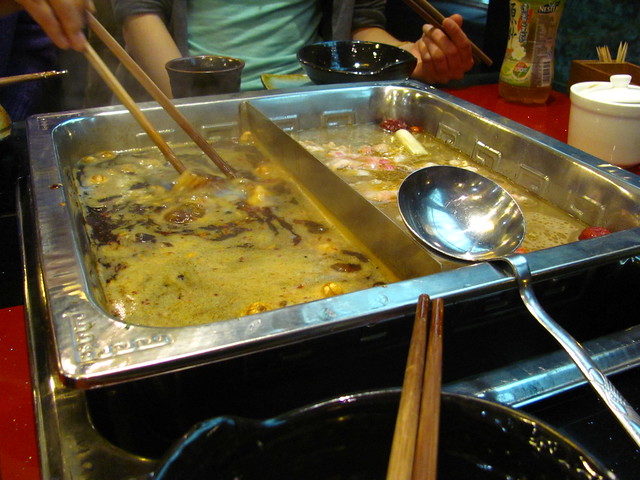


Comments